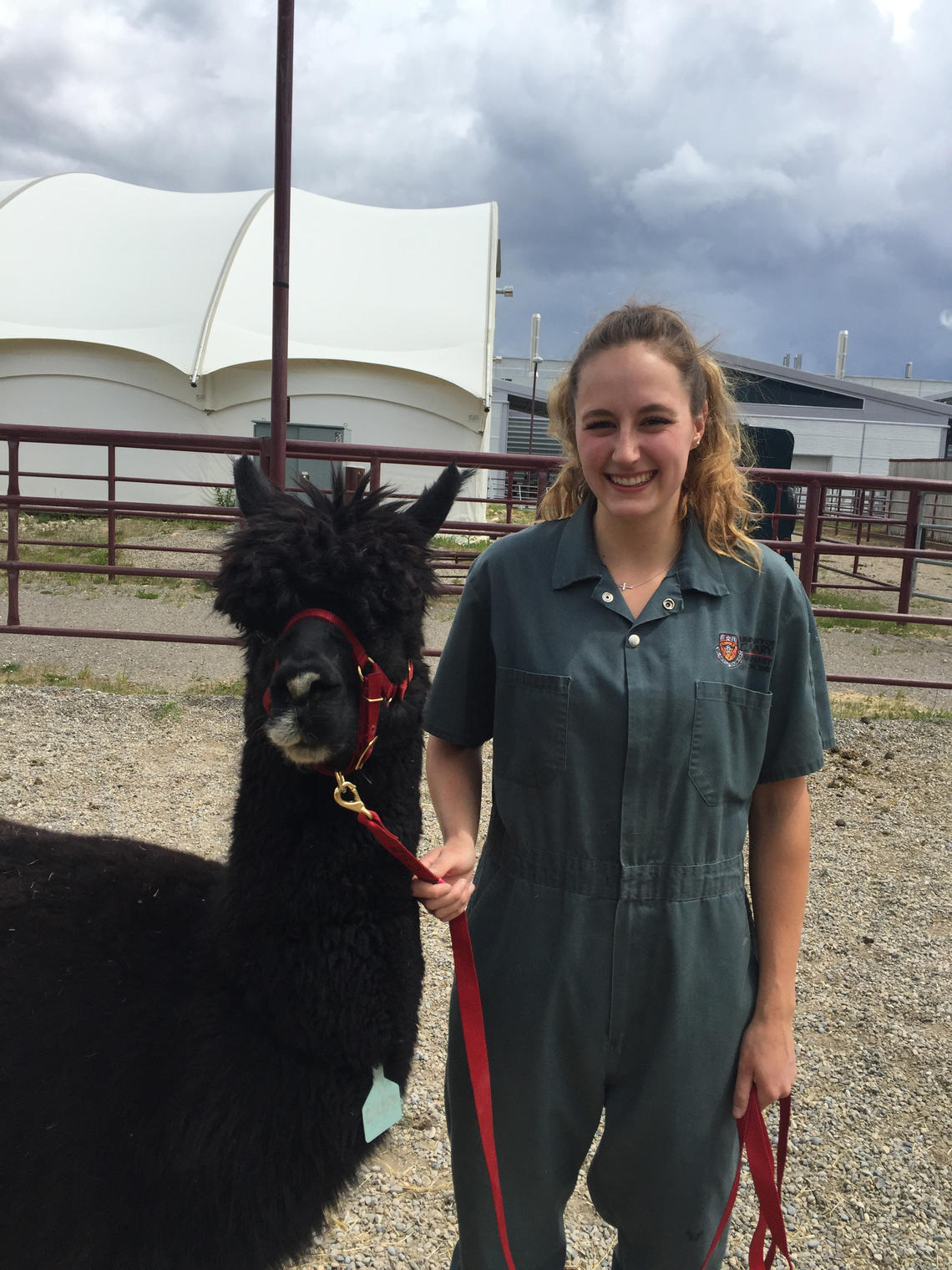
Lauren Sherwood plans to work with large animals such as cows, horses ... and the occasional alpaca.
Lauren Sherwood
May 21, 2019

When the call comes for help in the town of Vermilion, Lauren Sherwood bolts from her steak dinner in a local restaurant and jumps into her Toyota RAV4.
The urgent text to her phone from the nearby clinic is what gets her moving: “Potential C-section coming in 15 to 20 minutes.”

The fourth-year University of Calgary Faculty of Veterinary Medicine (UCVM) student is living and working in the central Alberta community, learning hands-on technical skills during a practicum with the Vermilion Veterinary Clinic.
Within five minutes, she’s at the facility, changing into scrubs and a set of UCalgary coveralls, ready to assist with the birth.
“It all ended fine, both the mom and the calf left with their happy owner,” says Sherwood, 28, who has chosen the ecosystem and public health track of the UCVM fourth-year program. “This rural practice is very season-dependent and in April it’s busy with calving, so I’m getting to do a lot.”
Of the 210 or so graduates of the UCVM program in the past seven years, 76 per cent (about 165 graduates) are working in Alberta.
The vet med students make up one segment of the hundreds of UCalgary students from various faculties — undergraduate and graduate alike — who fan out across the province to learn, teach and practise.
At any given moment, these students might be found in classrooms or emergency rooms, law offices or businesses, on performance stages or in the natural environment. Their professors can be found there, too — gathering research, conducting educational outreach, and sharing their expertise on a vast range of subjects critical to Alberta.
Some outreach focuses on geographically specific regions or ecosystems, centring on learning more about the challenges faced within a particular community. Other programs seek student placement in work-integrated learning opportunities.
Programs that are formal and established include the Werklund School of Education’s Community-based Bachelor of Education, Faculty of Social Work’s programs in Lethbridge, Edmonton and Calgary, and the Cumming School of Medicine’s Distributed Learning and Rural Initiatives (DLRI) and its popular House Calls program.
Whether programs are formal or ad hoc, the connections they encourage within Alberta communities spring from the need for research in particular areas and they dovetail with community needs.
Research programs and practicums build on strengths
Last year, UCalgary placed sixth in Canada’s Top 50 Research Universities rankings, having increased its sponsored research income over five years by 34.5 per cent — the second-largest increase in the U15 universities.
UCVM, for example, is becoming a research-intensive leader among North American veterinary colleges for its quality of research programs. Areas of strength include cattle health, infectious disease, pain and animal welfare, and veterinary education, among others.
Faculty of Veterinary Medicine Dean Baljit Singh says students in the final year of their program have done practicums that stretch throughout the province, from Peace River in the north to Fort Macleod in the south and beyond.
“Our students live in the communities where they work and learn, in the places where often they will find employment,” says Dr. Singh, PhD. “Our focus is to find our grads positions in Alberta and we have done very well. The communities and students get to know each other and we have excellent community engagement.”

Lauren Sherwood plans to work with large animals such as cows, horses ... and the occasional alpaca.
Lauren Sherwood
Responding to community needs
Connection to community is a key pillar of the University of Calgary’s Eyes High strategy.
The strategy extends three foundational commitments across the university: to sharpen focus on research and scholarship, to enrich the quality and breadth of learning, and to integrate the university with the community.
“Our main campuses may be physically located in Calgary and the surrounding area, but the impact of our work is so much broader than that,” says President Ed McCauley.
“We apply our research expertise and share knowledge with communities all over Alberta. Whether it’s through formal programs or informal learning agreements, student practicum placements or research projects, our relationships with community partners are strong. These Alberta connections help us to identify opportunities for initiatives and programs that allow our province to flourish.”
Made-in-Alberta teaching and learning solutions
Sherwood’s experiences in Vermilion speak to the UCVM faculty’s close ties with communities across the province.
UCVM is a born-and-bred Alberta phenomenon. Established in 2005 after Alberta’s cattle industry suffered the devastating effects of the BSE (mad cow disease) crisis, the university developed the program to fit within the province’s culture and environment.
Today, UCVM is the only veterinary school in Canada — and one of only a few in the world — employing a community-based teaching model instead of an on-campus teaching hospital model.
The program includes close connections with the Distributed Veterinary Learning Community (DVLC), comprising dozens of veterinary practices and other sites where fourth-year students gain clinical experience while doing a series of practicum rotations.
“When our fourth-year students live in communities across Alberta, they are enjoying working in action during a training program that is much like an extended job interview,” says Singh. “The faculty’s mission is to be of service to animal owners and the broader communities within the province. We are very much part of Alberta’s rich heritage and history as well as exciting future of agriculture.”
Sherwood, born in Edmonton and trained as a veterinarian at UCalgary, is a self-professed city girl who has discovered a new appreciation for rural living. Her time in Vermilion has been invaluable. After she graduates this summer, she, too, wants to stay and practise in Alberta.
“The clinic has been very encouraging and supportive,” says Sherwood. “Living in Vermilion, I’ve worked with a lot of friendly, outgoing people who’ve made a big effort to make me feel welcome. When you are engaged in the community, you can better understand how your clients live and they appreciate it.”